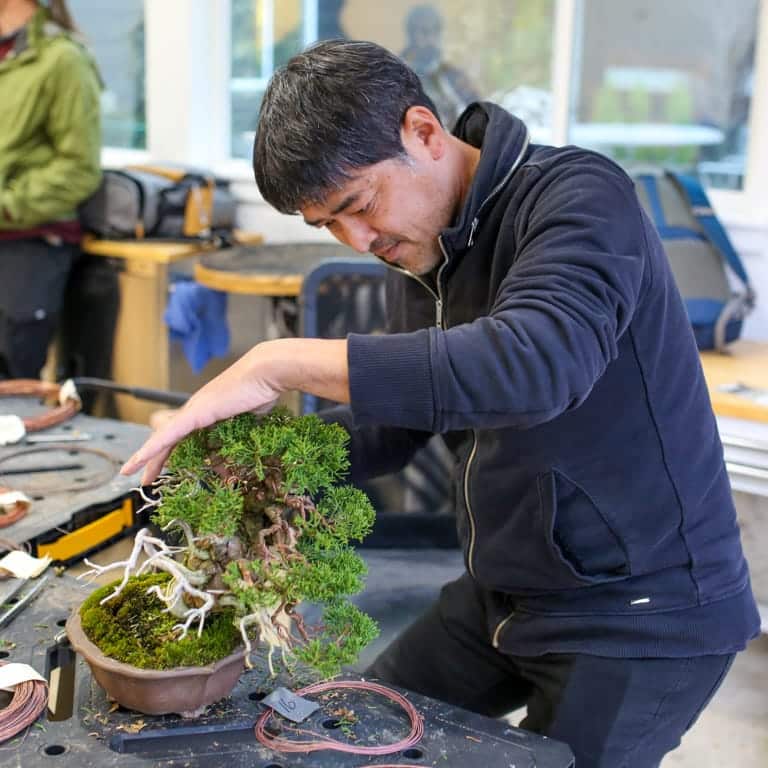Keying off last week’s theme, I wanted to share tips for workshop leaders. How does one host a successful workshop?
- Respect your students’ time.
- Clean the workshop and set up workstations before participants arrive.
- Try to the best of your ability to provide roughly equivalent time with each student. This is a perennial challenge for a variety of reasons – give it your best effort and try to improve over time.
- Not everyone can stay late after the workshop ends – provide warning near the end of the session so people can clean their workstations and head out in a timely fashion.
- Set clear expectations about who will do what.
- Some students want to do all of the work on their trees. Others bring trees to be worked on by the workshop leader. Both approaches can work well when expectations are clear.
- Don’t make irreversible design decisions without consulting the student who brought the tree. Even when instructors believe they are “right,” making hasty or unilateral decisions (like removing a key branch) can lead to ill will.
- Respect your students’ trees.
- Don’t feel pressure from students to work on trees that you deem to be weak or require some form of recovery before styling can continue. If the student is open to it, feel free to explain your perspective without overdoing it.
- Don’t pressure yourself to make changes that make the tree look different but not necessarily better. Encourage students to participate in finding the best design for the tree.
- Listen.
- It’s easy to offer unsolicited advice. Impress students by supporting their goals for their trees.
- Be flexible.
- There are often multiple ways of performing a technique or reaching a goal. Be open to helping students learn or practice techniques that differ from your standard approach.
- Be patient, and remember that bonsai is fun!
- Every form of teaching has its challenges, and every student has their limits. The workshop is the student’s time to do focused work on their trees. It’s OK if they do it at their own pace.
- Although everyone struggles with their trees at one time or another, there can be great joy in overcoming shared challenges. Find ways to keep the mood positive before the workshop becomes too intense.

Daisaku Nomoto working on a shimpaku juniper
There are lots of ways in which workshop leaders can instruct and inspire their students to do great work – share your tips in the comments below!
Subscribe to Bonsai Tonight
New Posts Delivered Every Tuesday and Friday
Darth Masiah says
Nice tips. seems like I’ve used them all already at one point or another in my head, arguing with myself before working on my trees 😁
scott chadd says
i spend some time at the outset to let the students share a bit of their background with each other. our workshops are 4-6 students and it seems to work well if i go around to each tree and talk about what the options are. once we have completed that initial dialogue i go round and round helping them with the work. the students can learn by observing what happens to other students bonsai.
Ryan / Ry2Tree2 says
Thanks for the write up Jonas and for the commenters who also shared ideas! I hosted my first BYOT workshop recently amd I definitely see the importance of having a structure like talking around the room about ideas for everyone’s trees before you get down and dirty helping people with their tasks. That should help it be organized and help on the equal time component.
Jonas Dupuich says
Thank you, Ryan, for suggesting the topic in the first place! Sounds like the workshop went well – am happy to hear it!
Paul Dominic says
Thank you Jonas. Did someone tell you I was holding at Intro Workshop at the San Jose Betsuin Bonsai Club ? Will use your tips of course , your article is timely.
Zack Clayton says
I think special attention should be paid to #s 3 and 4. Early on I had a yew clump collected from the corner of a garage where the wind had stripped the needles and small branches from one side of the uprights. I explained that I envisioned a group of timberline windswept trees. The visiting artist was firm in his, “Oh no, this would make a wonderful small grove, cut them back to about a foot tall and let them grow out short.” At the time I trusted that he knew what he was talking about. so almost all the remaining foliage came off and Surprise! it died. Not my vision, and sadly, finally not my tree.
Jonas Dupuich says
Sorry to hear it Zack – it sounds like it was a fun clump of trees!